THIAGI GAMELETTER:
December 2010
SERIOUSLY FUN ACTIVITIES FOR TRAINERS, FACILITATORS,
PERFORMANCE CONSULTANTS, AND MANAGERS.
TABLE OF CONTENTS
Masthead
Our mission statement, copyright notice, and cast
of characters.
Reflective Teamwork Activity
High Performance Teams
How to be a top team.
Structured Sharing
What Do You Do?
Practice your pitch.
Guest Gamer
An Interview with Bob Wiele
Conduct smarter meetings.
Improv
Group Order by
Tracy Tagliati
Line up in different orders.
Say It Quick
Too Much Talk! by
Brian Remer
Parental advice in 99 words.
Discoveries
Tagxedo by
Brian Remer
Make your own word clouds.
Ideas
Open Space Thinking by
Brian Remer
Analyze your writing with word
clouds.
Activities
Making Words Work by
Brian Remer
Using word clouds for evaluation and
review.
Singapore Workshops
Thiagi and Tracy in Singapore
With Stanis Benjamin.
Dallas Workshops
Attend Thiagi's Interactive Techniques for Instructor-Led
Training Workshop and become a Certified Trainer by
Tracy Tagliati
Our next public workshop in the USA.
Zurich Workshops
Thiagi and Sam in Zurich
On interactive strategies.
Single Topic Survey
Looking Back on 2010 by
Tracy Tagliati
The year is almost at its end.
Survey Results
Generation Gap in the Workplace by
Tracy Tagliati
A summary of your responses.
Webinar
Improve Your Training Sessions Through Improv
Games
Bend Your Brain with Thiagi and
Tracy.
Check It Out
Will Thalheimer's Learning Landscape Model
A bird's eye view.
Masthead
THIAGI GAMELETTER:
SERIOUSLY FUN ACTIVITIES FOR TRAINERS, FACILITATORS,
PERFORMANCE CONSULTANTS, AND MANAGERS.
Mission
To increase and improve the use of interactive,
experiential strategies to improve human performance in an
effective, efficient, and enjoyable way.
Editorial Roster
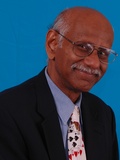 Author and Editor
: Sivasailam (Thiagi) Thiagarajan
Author and Editor
: Sivasailam (Thiagi) Thiagarajan
 Assistant Editor
: Raja Thiagarajan
Assistant Editor
: Raja Thiagarajan
Associate Editors: Jean Reese and Tracy Tagliati
Contributing Editors: Brian Remer and Matthew Richter
Editorial Advisory Board: Bill Wake, Matthew Richter, Samuel van den Bergh, and <type your name here>
Copyright Info
The materials in this newsletter are copyright 2010 by The
Thiagi Group. However, they may be freely reproduced for
educational/training activities. There is no need to obtain
special permission for such use as long as you do not
reproduce more than 100 copies per year. Please
include the following statement on all reproductions:
Reprinted from THIAGI GAMELETTER. Copyright © 2010
by The Thiagi Group, Inc.
For any other use of the content, please contact us (
thiagi@thiagi.com ) for permission.
Subscription Info
To sign up, or to donate and help us continue this
newsletter, please see the Online
Newsletter page on our website (
http://thiagi.com/pfp.html ).
Feedback Request
Thiagi believes in practicing what he preaches. This is an
interactive newsletter, so interact already! Send us your
feedback, sarcastic remarks, and gratuitous advice through
email to thiagi@thiagi.com . Thanks!
[Table of
Contents]
Reflective Teamwork Activity
High Performance Teams
Purpose
To select and implement guidelines for achieving high
performance in a team.
Participants
Four or more.
Time
30 to 45 minutes.
Handouts
-
Teamwork Guidelines (82k
PDF) (four different versions, one copy for each
participant)
-
Complete List of Teamwork Guidelines
(86k PDF) (one copy for each participant)
-
Teamwork Planning Form (45k
PDF) (one copy for each team)
Flow
Organize participants into teams of four.
If you have extra players, distribute them among the
teams.
Distribute copies of the Teamwork
Guidelines handout. Give a different
version of the handout to each member of the team. Ask the
participants to individually review the 10 guidelines listed
in the handout and to select three that will be the most
useful for helping the team complete its mission. Announce a
5-minute time limit and start the timer.
Ask team members to share and discuss the selected
guidelines. Pause for about 5 minutes. At the end
of this time, blow the whistle. Ask the team members to
share their selected guidelines. Explain that there is some
overlap among the guidelines from different handouts. So it
is possible that more than one team member selected the same
guideline. Ask teams to discuss their choices and select
five guidelines that must be applied to achieve their
mission.
Distribute copies of the Teamwork
Planning form. Ask the members of each
team to record their five selected guidelines in the first
column. (They don't have to copy the entire guideline; just
the heading will be fine.) In the second column, ask the
teams to write the name of a team member who will be in
charge of applying this guideline. Announce a 5-minute time
limit for completing the task.
Ask the teams to debrief their behavior.
Instruct the teams to use the selected guideline on the
Teamwork Planning Form as a 5-point
checklist. Ask the person responsible for each selected
guideline to lead a discussion to reflect on how the team
members carried out the previous tasks (of sharing their
selections and filling out the Teamwork Planning
Form). Suggest that the team should rate its
previous behavior on a 5-point scale where 1 indicates that
the guideline was ignored (or violated) and 5 indicates that
the guideline was effectively used. Announce a 5-minute time
limit.
Ask for improvement plans. After the team
has rated its previous performance, ask the team members to
brainstorm strategies for improving their scores on
individual guidelines and their total score. Roam around
different teams and listen to their discussion. Ask suitable
questions to focus their attention.
Conclude the activity. After a suitable
pause, remind participants that implementing the strategies
they came up with is a very important step.
[Table of
Contents]
Structured Sharing
What Do You Do?
I dread the moment when people ask me, “What do you do?”
I don't know how to explain that I am a performance
technologist, or an instructional designer, or a facilitator.
So I cheat by saying that I am a trainer.
Here's an activity that helps you become more fluent in
explaining what you do for a living.
Objective
To describe the nature and significance of your job.
Synopsis
Participants are divided into three teams. Members of each
team work cooperatively to come up with the best way to
explain their jobs. During the first round, two of the teams
have one-on-one conversations to toot their horns. During
the second round, members of the third team make individual
presentations.
Time
30-45 minutes, depending on the number of participants.
Flow
Form teams. Divide participants into three
teams. Label them A, B, and C.
Brief the participants. Give a pep talk
about the importance of being able to explain one's job
interestingly, concisely, and clearly. Ask team members to
brainstorm how they should talk about their jobs and to
practice their technique with each other. Announce a
5-minute time limit for this activity.
Conduct one-on-one conversations. Ask
participants to reorganize themselves into triads so that
each triad has one member of each team. Explain that the
member from Team A will act as a judge. Ask the Team C
member to cover her ears while the Team B explains her job
to the judge. Follow this with a similar presentation from
the Team C member. After the two presentations, the judge
quickly announces whose presentation was better and explains
why.
Conduct small-group presentations. Send
all members of Team A outside the room. Explain that the
members of Teams B and C will act as audience members. One
by one, Team A members return to the room and explain what
they do on their job. Immediately after everyone from Team A
has made her presentation, the audience members vote for the
best presentation.
Debrief the participants. Conduct a
discussion of what features made the presentations clear,
concise, and interesting.
Encourage personal action. Pause for a few
minutes while participants individually jot down the key
ideas from the activity so they can prepare a better
explanation of their job to others.
Variations
Do you have more time? Ask each team to
watch two different TED lectures. This will enable them to
discover how different presenters use the same humor
technique.
Do you have less face time? Ask
participants to watch different TED lectures before they
come to the face-to-face session. Also ask them to come
prepared with individual lists of humor guidelines.
[Table of
Contents]
Guest Gamer
 Bob Wiele modestly claims that he is more
of an inventor of thinking tools rather than a game
designer. The tools he developed are embedded into learning
programs that use games to open up learning and get work
done. The tools include the 4D-I online thinking and
operating styles personal development system and the new
Smarter Meetings program—a process mapping type of
framegames that help organizations save a lot of money and
teams engage their people to get more done in less time.
(Check out www.smartermeetings.com .) Bob's books include
Smart for Life, Smarter
Meetings, and Working with
Volunteer Boards.
Bob Wiele modestly claims that he is more
of an inventor of thinking tools rather than a game
designer. The tools he developed are embedded into learning
programs that use games to open up learning and get work
done. The tools include the 4D-I online thinking and
operating styles personal development system and the new
Smarter Meetings program—a process mapping type of
framegames that help organizations save a lot of money and
teams engage their people to get more done in less time.
(Check out www.smartermeetings.com .) Bob's books include
Smart for Life, Smarter
Meetings, and Working with
Volunteer Boards.
An Interview with Bob Wiele
TGL: Bob, what is your specialty
area?
Bob: Everything I do is built off our own
universal common language for connecting people and
accelerating collaboration. We use a traffic light metaphor to
describe three types of thinking and work: red — stop
and decide for decision-making; yellow — slow down,
develop understanding; green — go and get creative to
generate ideas and options. The fourth dimension, white, is to
appreciate and initiate for personal spirit. The four key
applications of this language and the tools are in leadership
development, team and meeting productivity, accelerating
change (with RIP IT and our Rapid Innovation Program), and
building 21st century skills for students in schools and
colleges.
TGL: How did you get into designing and using
games?
Bob: I am a green guy—a relentless
creative thinker and have always been looking for newer,
better, smarter ways of learning how to learn. It all began
when I started the first full time school for adult Inuit in
Canada's Arctic over 40 years ago. My students were in their
20s like me, but operating at the grade school level. So I had
to invent ways of how to learn stuff that worked for adults.
Since I had never gone to teacher's college, I was free to
figure it out as I went along. My M.Ed. helped me learn the
principles and my clients taught me the ways to
success.
TGL: How long have you been designing and
using games?
Bob: Almost as long as Thiagi.
TGL: Where do you use games?
Bob: In every thing I do with
people—from presentations to workshops to
organizational interventions. I use the word games to
mean having people do purposeful active things they were not
expecting to do when they turned up.
TGL: How do your clients
respond?
Bob: Depends on the client. The more open the
client, the more we engage them in the design process and the
more committed they are to games as a means to learning. The
more worried the client, the less we share the process, the
more we tell them to look at our client list so they know they
will be in good company no matter how it goes. We want all our
clients to look brilliant and get a promotion for having
selected us.
TGL: How do your participants
respond?
Bob: It's all in the framing and the naming.
If I feel great, make a quick, sound business case for why we
are doing this, and then toss them into it, they love it.
Bye-bye PowerPoint slides, hello powerful human
connections.
TGL: What is the most embarrassing moment you
had in conducting games?
Bob: Let me count the ways! Sleeping in and
forgetting to drive 100 miles to conduct an experiential
workshop with the client phoning me about his 75 people at a
lodge wondering what to do. Having a Bounce sheet
stuck to my rear end (no static cling?) during a workshop on
smart thinking. Sensitive people not appreciating my wonderful
sense of humor and getting upset. Using a competitive puzzle
game with 10 teams and realizing one of the teams was stuck
because they were missing a key piece. (I reframed the
activity on the spot: What is the missing piece?). The
toughest ones are the odd times when a game surfaces a deep
personal issue that brings tears or anger flowing out. Due to
the size of the group, the length of time available, and the
learning purpose, it is really difficult to deal with these
feelings properly in the context of the workshop
experience.
TGL: What advice do you give to newcomers
about interactive training?
Bob: Call me. I want to find great game
designers to work with who can take my content and your gaming
skills to co-develop and license game applications of our
system to help people think better and work smarter
together.
If you build a great design that is well thought through from
the participant's experience, clearly defined so people have a
clue about why they are doing it, structured at the outset so
they know what to do and it engages them right away, then let
it go and trust the people to do good work and the process to
get them where they need to go. When my kids used to ask,
“Hey Dad, what do you really do?” I would take a page
from Thiagi and pose a zen-like koan in response: “I am a
learning mid-wife. I am only there for the team's heavy
breathing while they birth a new solution. The baby is
always theirs and never mine.” I think that's why my son
Matt is now a horror movie producer.
TGL: What types of games do you use most
frequently?
Bob: I am an applied learning kind of
guy—more grounded in getting results than focusing on
the learning. I think of learning as means and not as end. Do
it right and you get both done. So, I often start a workshop
off with asking people to identify the most pressing issues
that require their best thinking. They focus on the complex
issues for which there is no obvious or simple answer.
Group Scoop works well here. The
reality is that it is always the same type of issues that come
up, no matter what the organization is. As the game designer,
I have no worries about what the answer needs to be. It is
clear that the participants will build solutions that work for
them. We park those critical issues on a flipchart and then
belt into learning the key skills in our Smarter Meetings team
productivity system (green for creativity, yellow for
understanding, red for decision making, and white for personal
spirit). We use cards, card games, job-aids, and simulations
to get people comfortable enough with the frameworks and the
behaviors. Then we go back and pick one or more of the big
issues they identified earlier and apply one of our smart lean
process tracks to enable the teams to think through
together—same page at the same time—and drive to
real solutions. I like the Fish Bowl
game to build skills with coaching and Detect and
Connect that build skills in observation,
different types of thinking, and coaching. We often finish
with one of Thiagi's integration exercises such as
Essence and
Backstabbing to nail down the
insights and to help sustain transfer.
TGL: What is your most favorite
game?
Bob: Anything that does three things: gets
people moving, gets them out of their comfort zone, and
connects them with other people in positive
ways.
TGL: Who are your favorite game
designers?
Bob: Thiagi, the leader of the pack. I also
have great respect for my friend and colleague, David Gouthro.
The big shift is to transfer the burden of learning and to
allow learning to emerge.
TGL: Do you have any book
recommendations?
Bob: Here are four books that I am enjoying
right now:
-
The Executive and the Elephant
by Richard Daft. An excellent self development
work.
-
Courageous Dreaming by Alberto
Villoldo. Much grist for the imaginative game designer in
this book.
-
Switch by the fabulous Heath
brothers. This should be required reading for all game
designers.
-
The Happiness Advantage by
Shawn Achor. Seven principles of positive
psychology.
TGL: What is your prediction about the future
of games?
Bob: Games are learning on steroids. All the
gens from X onwards will want to learn this way: real time,
simulation, virtual. Build the right games, make sure they
jolt you, and build the people skills that are the root cause
of all high performing teams and leaders.
[Table of
Contents]
Improv
Group Order
by
Tracy Tagliati
 Here's an energizing activity that helps
members of a group get to know each other, network, and
recognize what they have in common.
Here's an energizing activity that helps
members of a group get to know each other, network, and
recognize what they have in common.
Time
5 to 10 minutes.
Equipment
Whistle (or some other attention-getting noise maker).
Flow
- Ask participants to mill around the room for about a
minute.
- Blow the whistle and ask the participants to line up,
according to a specific criterion selected from this list:
- distance from home to the workplace
- birth date in the calendar year
- number of different countries visited
- number of letters in his or her middle name
- number of pets
- After the participants line up, blow the whistle and
have them mill around the room for a minute or so.
- Blow the whistle again and have the participants line
up according to a different criterion.
- Repeat the procedure as time allows.
[Table of
Contents]
Say It Quick
Too Much Talk!
by
Brian Remer
Sometimes our words have an impact we never intended. In this
issue, we'll discover some unique ways of visualizing the
impact of words beginning with this example of the problem in
just 99 words.
Too Much Talk!
I was having a heart to heart conversation with my
daughter. About to enter her teen years, I knew she would
benefit from my reflections of how to survive those
troubling pubescent times. As I revved up for a helpful
review of my main points, I looked over in her
direction.
She was staring into the middle distance with glazed eyes
and slouched shoulders. She'd been turned off. I'd been
tuned out.
Too much of a good thing had become another lecture. Less
is more. I wish I'd shared my sage advice in only 99
words!
[Table of
Contents]
Discoveries
Tagxedo
by
Brian Remer
A picture is worth a thousand words and a picture made
completely out of words is both beautiful and worth talking
about. That's the gist of this month's Discovery
suggested by Jose Ochoa of Madrid, Spain. Jose was inspired by
the lyrics from Dan Bern's song “Jane”,
referenced in last month's issue about attention, to make a
word cloud using Tagxedo ( http://www.tagxedo.com/ ).
Word clouds evolved from the efforts of web developers to
create a visual representation of the frequency of tag words
in a document. There are many word cloud generators that are
free as well as those for subscribers. Some, like Tagxedo and
Wordle (which I have used in other issues of this newsletter;
http://www.wordle.net/ ) offer many options for
customizing the cloud as a work of art. Others like Wordsift (
http://wordsift.com/ ) take a more grammatical
perspective providing links to synonyms and images for the
purpose of strengthening writing skills.
I have more experience with Wordle but I've become a quick
convert to Tagxedo which has so many more options for
customizing a word creation. One of the most interesting is
the ability to import a graphic like a portrait or logo which
acts as a stencil for the word cloud pattern. The Tagxedo site
also has a presentation with 101 ways to use a word cloud - a
great inspiration for anyone who, in addition to reading them,
loves to look at words.
|
Tagxedo |
Wordle |
| Fonts |
34 with options to add more |
30 |
| Color Themes |
More than 16 plus add and customize |
15 |
| Layout |
Horizontal, Vertical, Both, or Random |
Horizontal, Vertical, Both, or Random with options for
round or smooth edges to the cloud |
| Saving |
5 options |
Print or Save to Gallery |
| Shapes |
50 options plus add your own |
XX |
| Printing |
Print on a T-Shirt |
XX |
| History |
Experiment with different designs but still find that
one you really liked 10 minutes ago |
XX |
| Extras |
101 Ways to use Word Clouds |
XX |
Read a brief review of several other word cloud generators
here: http://21centuryedtech.wordpress.com/2010/02/28/waiting-for-wordle-free-word-cloud-options-to-use-now/
[Table of
Contents]
Ideas
Open Space Thinking
by
Brian Remer
As the 99-Word Story this month suggests, we can easily
become carried away with talk. Our words, as they spill from
our mouths, take on a life of their own with results we may
not have intended. One way to address this might be to use
fewer of them!
Though it can be difficult to do that in real time when
emotions and urgency are also strong factors, writing is a
different story. If you examine this word cloud created in
Tagxedo from “Too Much Talk!” (the
99-Word Story selection above)
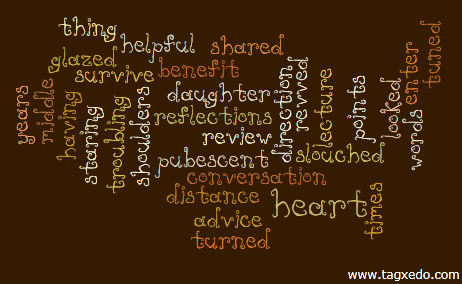
you'll notice most of the
words have the same weight. This reflects the careful
attention to word usage needed to write in just 99 words. If
you aren't using many words, you tend to be choosy!
Tools like Wordle and Tagxedo make it easy to analyze the
impact of written words. Visual representations of text can
show frequency of words used and reveal the underlying
emphasis of the text. Create a word cloud of a news article or
a speech and with a quick visual scan, you get the gist of its
overall theme.
Or, if you're stuck without a muse, look at your writing in a
completely different way. Here's a new perspective, with new
inspiration, from the previous three paragraphs. The
repetition of vocabulary actually makes the graphic more
appealing.
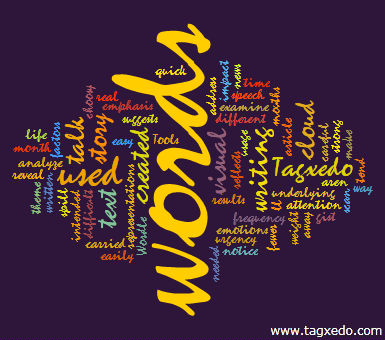
It's interesting to consider how words take up space.
Spoken, they can fill an awkward silence or crowd
out the thoughts of a careful thinker. Written, they
can cover the page leaving only a slim margin while
metaphorically they might also fill the mind. As a
cloud, words and the spaces around them contribute
to one harmonious design. For me, it's a helpful reminder to
use my own words in a way that opens more space for the words
and ideas of others. When that happens, I usually learn
something too!
If these ideas have opened some space for your thoughts, I
hope you'll share what you've learned (email Brian)!
[Table of
Contents]
Activities
Making Words Work
by
Brian Remer
Play with word clouds yourself and you will probably invent
more than one way to apply them in your own setting. After
seeing word clouds from the last issue of the Firefly News
Flash, Jennifer van Stelle shared how she uses them for
evaluation.
She writes, “Here's a word cloud I made last year, showing
students' favorite activities in UCSF's three-week
experiential summer program for high school juniors
interested in exploring careers in science and health care.
As you can see students' most favorite activities were
hands-on (often in the lab), or relational (meeting
people).”
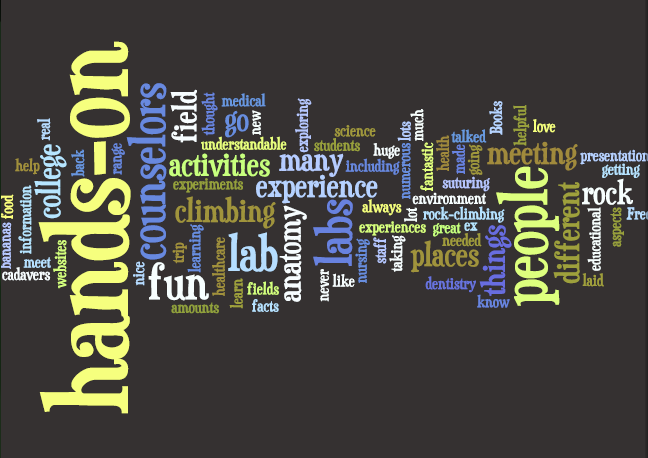
In my own work, I was recently asked to help a church group
reflect upon their accomplishments from the previous year.
Here's how I incorporated the use of a word cloud into the
day's activities.
Each person was given four blank cards and asked to write
what they thought were the most significant accomplishments,
one per card. All the cards were collected and redistributed
randomly to all participants. People were then asked to mill
about the room reading each other's cards and trading when
they wished to get four cards they felt were the most
important achievements.
Next, people organized themselves into groups of four to six
and, looking at all their group's cards, they selected three
as the most significant achievements for the year. Groups
shared these with everyone.
While people worked on the next task, making a collage to
represent projects for the future, the notes about their
achievements were fed into Tagxedo. In a few minutes, I was
able to project a giant, colorful graphic representation of
the past year on the wall. As you might guess, the effect was
both dramatic and satisfying.
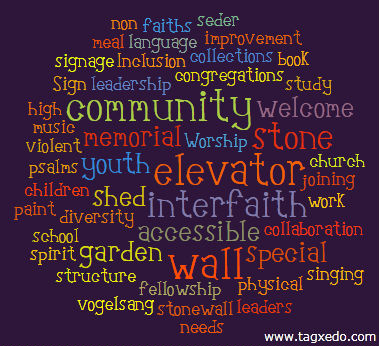
If you use word clouds in an interesting way, please share
them (email
Brian) and describe the results!
[Table of
Contents]
Singapore Workshops
Thiagi and Tracy in Singapore
Tracy and Thiagi will be conducting their workshops in
Singapore. Here are brief descriptions of two workshops
organized by our colleague Stanis Benjamin.
3-Day Workshop
Interactive Training
Strategies
Agenda:
Day 1: How To Design Training Games and
Activities. Day 2: How To Design Different
Types of Training Simulations. Day 3: How To
Conduct Training Games, Simulations, and Activities.
Dates: January 11, 12, and 13, 2011.
Venue: Grand Park City Hall, 10 Coleman
Street, Singapore 179809.
Registration fee: Singapore$2250
(approximately US$1650)
1-Day Workshop
Follow-Up and Certification
Workshop
Requirement: Completion of the 3-day
workshop on Interactive Training
Strategies within the past 2
years.
Agenda: Advanced interactive strategies:
online games and simulation, outdoor adventures, and
positive psychology exercises. Facilitation challenges:
intercultural participants and controversial topics.
Training design: Rapid prototyping and levels of evaluation.
Design clinic.
Date: January 14, 2011.
Venue: Grand Park City Hall, 10 Coleman
Street, Singapore 179809.
Registration fee: Singapore$450
(approximately US$330)
For more information, download the brochure.
[Table of
Contents]
Dallas Workshops
Attend Thiagi's Interactive Techniques for Instructor-Led
Training Workshop and become a Certified Trainer
by
Tracy Tagliati
 Did you miss out last year? Here's your
chance to attend Thiagi's Interactive Techniques for
Instructor-Led Training Workshop. Attend the fourth day and
become a certified Thiagi trainer.
Did you miss out last year? Here's your
chance to attend Thiagi's Interactive Techniques for
Instructor-Led Training Workshop. Attend the fourth day and
become a certified Thiagi trainer.
This event sold out last year.
When
March 28-30, 2011
Where
Courtyard by Marriott Dallas Central Expressway
10325
North Central Expressway
Dallas, TX 75231
USA
(214) 739-2500
Planning on staying at the hotel? We have blocked off a
limited number of rooms at a discounted rate of $99. Mention
“The Thiagi Group” to get the best price when booking
your room.
The 1-day certification workshop (that licenses you to
conduct this workshop) will be held on March 31, 2011 at the
same location.
If you register now, you save $370 for the 3-day workshop and
$125 for the 1-day certification program.
Here are some additional details about these workshops. You
can also download a detailed brochure (194k PDF).
Registration Fees
- 3-Day Workshop (March 28-30, 2011): $1,495
- 1-Day Certification Workshop (March 31): $495
Early Bird Discount
If you register before January 15, 2011
- 3-Day Workshop (March 28-30, 2011): $1,125 (save
$370)
- 1-Day Certification Workshop (March 31): $370 (save
$125)
Group Discount
Groups of three or more who enroll at the same time will
get a 15 percent reduction on their registration fees.
Two Easy Ways to Register
Online. Visit our online store at
thiagi.com and click on “Workshops: 2011”. (You will automatically be
given the early bird discounted fee.)
Telephone. Call (812) 332-1478.
What You Get for Your Registration Fee
3-Day ITILT Workshop
- Manual, Interactive Techniques for
Instructor-Led Training
- Manual, Simulation Games for
Instructor-Led Training
- Additional handouts
- Continental breakfast
- Two refreshment breaks
- Certificate of Accomplishment
- Access to Thiagi's web site
- One-year subscription to the Thiagi
GameLetter
1-Day Certification Workshop
- Book, Framegames by
Thiagi
- Book, Simulation Games by
Thiagi
- Additional handouts
- CD-ROM with Handout Masters
- Set of slides
- Licensing Agreement
- Access to Thiagi's web site
- One-year subscription to the Thiagi
GameLetter
- Listing on Thiagi's website as a certified
trainer
- Discount on Thiagi's books and games for use in your
workshops
- Certificate of Accomplishment
More Information
For more information, please download our detailed brochure (194K PDF)
[Table of
Contents]
Zurich Workshops
Thiagi and Sam in Zurich
Van den Bergh Thiagi Associates are happy to offer their
tenth annual workshops in Winterthur, Switzerland (near
Zurich).
Workshop 1: Interactive Training Strategies
June 21-23, 2011 (three days)
This workshop is designed for trainers, instructional
designers, facilitators, managers, and performance
consultants. The workshop helps a wide range of
practitioners, from newcomers to experienced specialists, to
master skills and concepts related to different types of
training games, simulations, and learning exercises.
This workshop practices what it preaches. Participants
learn new principles and procedures and apply them to
creating and conducting different types of learning
activities that meet their training objectives, audiences,
and needs.
Workshop 2: Design Clinic and Advanced Interactive
Strategies
June 24-25, 2011 (two days)
This workshop is designed for participants who have
completed Thiagi's 3-day Interactive Training Strategies
workshops.
The workshop design strongly incorporates individual needs
of the participants. At present Thiagi suggests the
following three major components:
- A design clinic in which Thiagi and Sam will provide
consultative advice and feedback on interactive training
activities that you are currently designing (or planning
to design).
- Peer review and support that uses structured
strategies to encourage you to present your ideas, plans,
and problems to your fellow participants and receive
valuable feedback and guidance.
- Advanced sessions on interactive strategies and
facilitation techniques. Selected topics will include
facilitating multinational and multicultural groups,
online games, interactive webinars, positive psychology
activities, and intrinsic motivation.
Bonus: The workshop will provide you with
a software package for designing online games and train you
how to use it.
More Information
For more information, please download our detailed brochure (615k PDF)
[Table of
Contents]
Single Topic Survey
Looking Back on 2010
by
Tracy Tagliati
 Training professionals faced a lot of
challenges in 2010: outsourcing, budget cuts, and
unemployment, just to name a few. All of this may make us
tempted to skip a 2010 review and go straight to planning for
2011. But that would mean skipping the opportunities and areas
of growth that 2010 has also brought—such as the
emergence of new social media possibilities, the increase in
technology-based delivery methods, and the slow but steady
increase of dollars spent in learning and development
departments.
Training professionals faced a lot of
challenges in 2010: outsourcing, budget cuts, and
unemployment, just to name a few. All of this may make us
tempted to skip a 2010 review and go straight to planning for
2011. But that would mean skipping the opportunities and areas
of growth that 2010 has also brought—such as the
emergence of new social media possibilities, the increase in
technology-based delivery methods, and the slow but steady
increase of dollars spent in learning and development
departments.
Poll Question
As a training professional do you think the opportunities
in 2010 outweighed the threats?

(The poll opens in a new window.)
Open Question
What do you think were the top influences in the training
industry in 2010?

(The survey opens in a new window.)
Feel free to include your opinions, anecdotes, guidelines,
suggestions, or anything else on your mind.
You may include your name along with your response, or if
you prefer, keep it anonymous.
We asked some of our colleagues, and here is a partial list
that they created.
Clotilde: I think 2010 was an explosive
year for social media in our industry. Many companies that I
consult with are embracing Twitter and Web 2.0 like they
were the next overhead projector.
Thuany: The hiring freeze has forced my
company to develop the talent of its current employees. We
hope that in the long run this will result in employees who
stay longer and reduce the training costs.
Aaron: I've found that the unexpected
benefit of cost cutting measures is that companies are going
more “green”. For example, computers and lights are
shut off at night, more documents are read electronically
rather than printed, and water is served from pitchers
instead of being served in individual water bottles.
Anne: My company has increased their
outsourcing and off-shoring activities. This has reduced
costs, but it has also lowered employee morale and increased
our company's security risk.
[Table of
Contents]
Survey Results
Generation Gap in the Workplace
by
Tracy Tagliati
 Last month we asked if you thought the
generational differences in the workplace were just a myth.
Here's how you responded:
Last month we asked if you thought the
generational differences in the workplace were just a myth.
Here's how you responded:
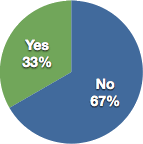
(Percentages reflect votes received by November 23, 2010.)
We also asked for your thoughts about the different
generations in the workplace. Here's what some of you had to
say.
Response 27) I have boomers, gen x and gen y. I see more
variation by MBTI than variation by age. We may be different
ages but we are the same species and I am not sure we have
evolved that much in 60 or 70 years.
I have as many gadgets as the 23 year old on my team and
may know a little more than they do about the latest apps.
The one variation is the use of gmail vs yahoo mail (or aol
or hotmail) The younger people are the more likely they are
to be on gmail.
Response 25) I really notice generational differences
around telecommuting/working from home. The younger
generation is used to working anywhere and I notice the
older generation still associating working hard with total
hours spent at desk, rather than with results. There's a
fluidity to the lifestyle of the younger generation that can
be leveraged by employers if they can learn to embrace
it.
Response 11) People of different ages are often more
comfortable doing things the way those of the same age do
but I am not sure that it is fair to label them of a
particular gen type.
Personality has a lot to do with how people behave.
See more
readers' responses or add your own.
Thank you for your responses.
[Table of
Contents]
Webinar
Improve Your Training Sessions Through Improv
Games
Tracy and Thiagi are doing a monthly webinar series,
sponsored by Training Magazine Network. You can attend for
free, but you must register.
Here's the description of this month's webinar:
Based on sarcastic slights from corporate types, we have
identified three major objections to using improv sessions
for training purposes. Using an interactive improv approach,
we will explore strategies for reducing and removing these
complaints. You learn how to adapt improv games to improve
their instructional effectiveness. In this walk-the-talk
session, you will explore and plagiarize improv strategies
for improving human performance.
This month's 60-minute webinar will take place at 1pm Eastern
Standard Time on Tuesday, December 14, 2010.
For more information, see the webinar's page at http://www.trainingmagnetwork.com/topics/show/2237 .
You may need to register (and log in) before you can view the
webinar description.
[Table of
Contents]
Check It Out
Will Thalheimer's Learning Landscape Model
I have learned a lot from trainers with street smarts and
practical experience. But sometimes the tips from these
friends lack conceptual rigor and research backing.
I have learned a lot from academic friends who shared their
evidence-based prescriptions on how to improve training. But
sometimes the prescriptions from these friends do not directly
apply to real-world corporate training.
I have learned a lot from Will Thalheimer, and I still
continue to learn from him. Will has a unique combination of
practical experience and scholarly discipline. He reads many
more juried journals than I do and he has worked with several
corporations.
Will has recently created a YouTube video that elegantly
summarizes his model of learning. This is a very practical
model and I have immediately used it to adjust the current
training courses that I conduct.
Take a few minutes to check out Will's Learning Landscape
Model ( http://www.youtube.com/watch?v=CIYHFVXzbZk ). You
will be a better trainer and training designer for it.
[Table of
Contents]
 Author and Editor
: Sivasailam (Thiagi) Thiagarajan
Author and Editor
: Sivasailam (Thiagi) Thiagarajan Assistant Editor
: Raja Thiagarajan
Assistant Editor
: Raja Thiagarajan Bob Wiele modestly claims that he is more
of an inventor of thinking tools rather than a game
designer. The tools he developed are embedded into learning
programs that use games to open up learning and get work
done. The tools include the 4D-I online thinking and
operating styles personal development system and the new
Smarter Meetings program—a process mapping type of
framegames that help organizations save a lot of money and
teams engage their people to get more done in less time.
(Check out
Bob Wiele modestly claims that he is more
of an inventor of thinking tools rather than a game
designer. The tools he developed are embedded into learning
programs that use games to open up learning and get work
done. The tools include the 4D-I online thinking and
operating styles personal development system and the new
Smarter Meetings program—a process mapping type of
framegames that help organizations save a lot of money and
teams engage their people to get more done in less time.
(Check out  Here's an energizing activity that helps
members of a group get to know each other, network, and
recognize what they have in common.
Here's an energizing activity that helps
members of a group get to know each other, network, and
recognize what they have in common. Reprinted from the
Reprinted from the  Reprinted from the
Reprinted from the 



 Did you miss out last year? Here's your
chance to attend Thiagi's Interactive Techniques for
Instructor-Led Training Workshop. Attend the fourth day and
become a certified Thiagi trainer.
Did you miss out last year? Here's your
chance to attend Thiagi's Interactive Techniques for
Instructor-Led Training Workshop. Attend the fourth day and
become a certified Thiagi trainer.

